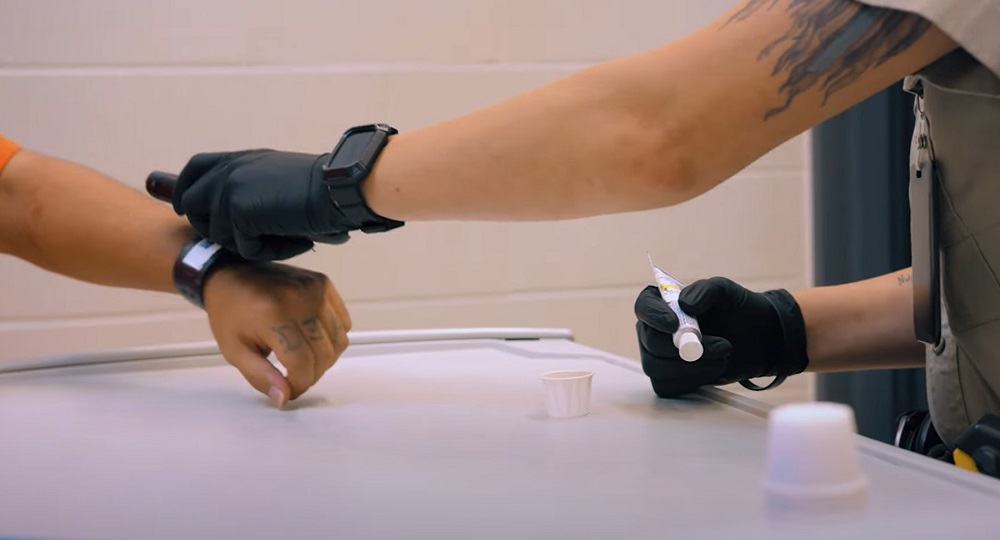An Inmate Claims They Weren’t Offered a Meal - How to Prove Them Wrong
The clock is ticking down to chow time. You know the drill. As you start to make your way toward the housing units to dispense meals, you realize it’s almost time to do a security check. You think, “If I’m about to distribute meals, do I still need to do a security check?” The answer to this is always, “Yes.”
If you were to reframe the question to, “Can documenting the well-being of the inmates be put on hold?” you’d quickly realize that you shouldn’t skip a security check just because another task item is approaching. Although it’s another to-do on your plate, completing cell checks allows you to politely wake up the inmates and let them know food is on the way, which may even speed up the meal process.
Now that you’ve completed your security check and the inmates are starting to line up, it’s time to pass out trays. Sounds simple enough right? Unfortunately, not always. This blog covers the meal distribution from start to finish to ensure each inmate is offered a meal and to improve defensibility against inmates claiming they never received a meal when they did or were at least offered.
Logging Meals
When distributing trays during meals, staff must know who has dietary restrictions, who has already received a meal, who still needs a tray, and which inmates refused their meals. The best way to do that is through diligent and clear logging. Let’s consider logging options to maintain a clear record in case an inmate claims they didn’t receive a meal when they really did.
First, verify how many trays belong in a pod. Start by scanning the Hard Tag located outside the door and find the total number of inmates currently assigned inside the pod and assigned as out-of-cell. The total number on your screen gives you an idea of how many trays to bring in the pod with you. Using SPARTAN’s Meal module makes it simple to keep track of who is receiving what.
Once you’re ready to start handing off trays, select the green “Accepted” column and scan each inmate ID card or wristband (that displays the specific inmate’s credentials) of the inmates who accept their trays. The same steps can be taken for inmates who refuse their meals, which can be completed by simply selecting the red “Declined” column and scanning the inmate ID card or wristband of the inmates who are declining their trays.
Using the Meal module simplifies the process of avoiding duplicate trays by recording when an inmate accepts or declines a meal. A notification will appear on the SPARTAN device if the meal has already been offered. If your facility doesn’t use ID cards or wristbands, there’s another solution to logging which inmates accepted or declined their meals. Locate the Offered column and manually swipe left (decline) or right (accepted) once the inmate has been offered their meal.
Once the officer completes the meal offerings, they should select the Save button. The Meals module will then close and the Cloud icon on the bottom left will turn green, then back to white, signifying all logged information was successfully uploaded to the Cloud.
What’s The Worst-Case Scenario?
Of course, some staff may argue that they have a strong enough memory to make their own “Mental Meal module” and can track everything on pen and paper. Sure, that could work to some extent but it’s hardly reliable. It’s difficult to remember the exact details off the top of your head, especially considering how hectic the corrections environment can be. In contrast, electronic logs capture more accurate, detailed data than manual logs.
One can assume that an officer can remember an inmate’s name, date, time, and location of a meal pass. On the other hand, it’s also fair to presume that the same officer can be interrupted by distractions, leaving the manual log susceptible to error. Even if the distracted officer claims they can still provide accurate information in a manual log, that information can be illegible, backdated, or falsely edited after the initial documentation.
So, let’s dive into the worst-case scenario. What happens when an inmate claims they weren’t offered a meal and the officer who uses their own “Mental Meal Module” can’t find the documentation proving that the inmate was offered a meal? Now, the inmate is threatening to sue the agency for cruel and unusual punishment and all the officer can think about is causing the agency to face litigation.
This is completely preventable.
If the officer had used the SPARTAN’s Meal module while offering meals and had properly documented if the inmate accepted or declined, the inmate's claim of not being offered a meal could have easily been proven true or false. The Meal module contains all the documented information and of course, the more detail that can be included, the more defensible the data is. Collecting information such as the inmate's name, date, time, location, officer number, and even photo evidence of the meal pass are all factors that drastically increase indisputability against any inmate meal-related complaint.
Although photo evidence is not necessary for every single meal pass ever recorded, it’s a best practice to use when officers need to hand out trays with religious restrictions, such as Low Sodium, Vegetarian, Kosher, or Halal meals. It is also helpful if medical staff request a record of meal documentation in case they need to know what exact food or how much food was consumed by an inmate. Documenting specific meal restrictions or medical requests adds more defensibility to an inmate claiming they weren’t served the correct meal.
With the SPARTAN, we’re able to scan inmates as they receive their meal. Once in a while, you’ll find that a tray or two wasn’t claimed by anyone. We can easily tell who is missing a tray and then we can go physically find the inmate and see why they didn’t get a tray. Or conversely, inmates sometimes try to get in line twice for a second meal and the SPARTAN gives us a notification that it’s a duplicate.
Travis LindstromJail Sergeant | Sherburne County, Minnesota
Regardless of how defensible the data you’re collecting is, there will still be inmates who say they weren’t offered the correct meal or a meal at all. (Hint: this is where it gets fun!) When a meal complaint occurs, staff will only need to click a couple of buttons to locate the reports to prove that the inmate in question was indeed offered a meal and whether they accepted or declined it.
This is why GUARDIAN RFID preaches documentation.
Logging specific records (such as “accepted” or “declined”) creates the utmost defensibility as it proves that an officer accurately recorded whether the inmate accepted or refused the tray in question. Further, defensibility can be increased by properly using inmate identification, such as wristbands or ID cards, as it ensures that all shifts are enforcing an ID policy verifying that all inmates are encountered during meal times. Any time an officer scans an inmate ID with their unique identifier, it proves that there was verifiable contact made between the said inmate and the officer.

Referencing the Collected Data Can Save Time and Money
All reporting can be located by logging into your facility’s OnDemand account. Your activity feed will show the number of inmates who accepted and declined their meals out of the total number of inmates in the specific location you’re viewing. For example, you can see that 30/35 accepted meals and 5/35 declined meals.
The various filter options while pulling a report are especially useful when pinpointing precise information. Officers don‘t have the time to sort through irrelevant data, so Meal modules were built to eliminate white noise and detect exactly what is being searched for. Within a matter of moments, the inmate’s claim is disputed and the officers can get back on task. The ease and speed of finding and pulling the reports further proves that electronic logging is more efficient than manual logging.
Not only are hours upon hours saved with SPARTAN’s Meal module, but so is money. Think about it, fewer meals made = less money spent. Providing the kitchen staff with several meals to make ahead of time helps eliminate having extra trays. After scanning a hard tag, a list of inmates who are assigned to that location should appear on the screen and you can gather a headcount number.
One popular practice that many facilities use is to make additional trays in case of new intakes or other unexpected situations where meals are needed. Why? Because one of the largest areas for inmates complaints, grievances, lawsuits, and riots all come back to the root of food service. In some scenarios, officers can be proactive about letting the kitchen know how many trays to make by considering the population that typically accepts and declines their meals from the total headcount number they’ve collected.
For example, suppose meal reports have historically shown that 85% of the inmate population accepts meals for breakfast and 15% decline. In that case, the officer has the option to apply these percentages to the overall number they provide the kitchen staff. So, if an officer knows that 15% of a specific unit usually declines meals, they can choose to let the kitchen staff know to reduce their production by around 5%, as the other 5-10% should be used for a buffer. Depending on the size of the facility, 5% may be a very small or very large number. However big or small, that is 5% of staff time and energy saved, funds allocated towards food not spent, and the food not going to waste.
There’s no argument that tracking inmate meals will inevitably save your agency energy, time, money, and possible litigation. With the accurate documentation inside of GUARDIAN RFID’s Meal module, an officer can easily and quickly prove if an inmate’s claim of not being offered a meal is true or false. If you’re interested in learning more about the Meal module or have questions on whether it would be an ideal feature for your facility, please reach out to our C.O.R.E. team who’d be happy to answer any questions. GUARDIAN RFID’s ultimate goal is to get your team home safe, and making sure your team can save their sanity is the first step.

